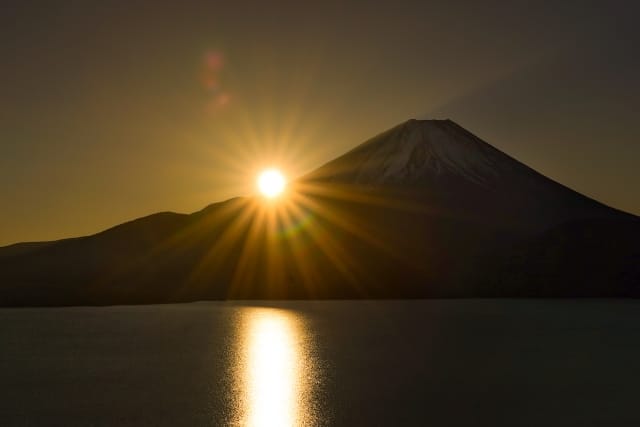Witness the Majestic 'Goraiko': Your Ultimate Guide to Experiencing Sunrise from Mt. Fuji's Summit
Due to Mount Fuji's massive size and the scattered tourist spots around its base, planning an efficient itinerary can be quite challenging for visitors. I remember when I first visited the Mount Fuji area, I wasn't able to efficiently visit the surrounding attractions, which left me feeling like I hadn't fully experienced what the region had to offer.
As a result, tours that offer an efficient and immersive way to experience the Mount Fuji area are gaining popularity. Private tours led by guides who know the Mount Fuji region inside and out are especially in demand, as they're known for allowing small groups to fully enjoy both the cultural and natural attractions around the mountain.
Magical Trip, which boasts having the #1 rated tour of 2024, launched a new tour in November 2024 called "Mt. Fuji Full-day Nature Guided Tour with a Private Chartered Car." On this tour, a driver and an expert local guide take you to carefully selected must-see spots around Mt. Fuji while explaining the local culture and traditions.

Since the tour starts and ends at your Tokyo hotel, you can explore the Mt. Fuji area hassle-free. If you're interested in Mt. Fuji but don't have time for an extended stay in the area, consider this efficient sightseeing tour.
Introduction
Standing at 3,776 meters, Mt. Fuji is Japan's highest mountain. When viewed from afar, its beautiful and overwhelming presence has made it beloved as a symbol of Japan. The summit of Mt. Fuji is also the spot where you can observe the sunrise at the earliest time in Japan. The sunrise viewed from Mt. Fuji is called "Goraiko" and offers a mystical beauty.
Additionally, the highlands around Mt. Fuji features many spots where you can experience the magnificent natural beauty, including lakes. Watching the sunrise in combination with Mt. Fuji from these locations is also very popular.
In this article, we'll introduce ways to maximize your enjoyment of Goraiko from Mt. Fuji, as well as spots around Mt. Fuji where you can enjoy the collaboration of the mountain and sunrise.
What is "Goraiko," a Uniquely Japanese Expression?
"Goraiko" refers to the sunrise viewed from high mountains like Mt. Fuji. The term originates from the Buddhist word "Raiko" (来迎), which means "welcoming."
Raiko specifically means the coming of Buddha to welcome believers. When you face away from the sun at the summit during sunrise, you can see your shadow cast on the clouds ahead. This shadow appears mystical, like a Buddha figure with a halo of light, which led to the term "Goraiko" derived from "Raiko."
Furthermore, in Japanese tradition, it's believed that gods dwell in the sun and mountains. This is why Goraiko is regarded as a mystical and grateful presence.
Mt. Fuji is Definitely Recommended for Viewing Goraiko!

If you want to see Goraiko in Japan, Mt. Fuji is highly recommended. While lower atmospheric clouds spread around 2,000 meters altitude, the 5th station of Mt. Fuji is located above 2,400 meters, allowing you to view the sea of clouds below from any point during your climb. The sea of clouds spreading across the horizon creates a spectacular view, and the morning sun rising through it is mystical.
The Goraiko viewed from the summit, which sits far above the sea of clouds, is particularly breathtaking and will make you appreciate the magnificence of nature. Moreover, Mt. Fuji's summit is the spot where you can observe sunrise at the earliest time in Japan. Viewing Goraiko from Mt. Fuji will become a memorable experience that stays with you for life.
3 Things You Should Know to Enjoy Goraiko at Mt. Fuji's Summit
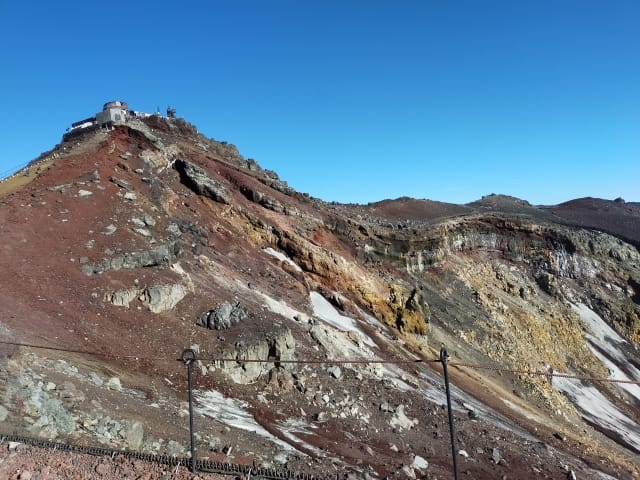
Sunrise Times Vary Significantly by Season
Sunrise times vary greatly depending on the season. Even during Mt. Fuji's climbing season, there's more than a 30-minute difference between July and August.
Approximate Sunrise Times at Mt. Fuji Summit:
* July 1st: 4:30
* July 15th: 4:40
* August 1st: 4:50
* August 15th: 5:00
* August 30th: 5:15
Be sure to check the sunrise time in advance when planning to view Goraiko.
There Are Several Spots Particularly Suitable for Goraiko
There are several spots on Mt. Fuji that are particularly suitable for viewing Goraiko. These are all spectacular viewing points that I confidently recommend. Since popular spots get crowded during Goraiko time, make sure to plan your schedule thoroughly before attempting the climb!
Kengamine (The Summit)

Kengamine is Mt. Fuji's highest point. The summit of Mt. Fuji is a crater with a 780m diameter and a 3km circumference. Among this area, Kengamine marks the exact 3,776m point. Watching the Mt. Fuji Sunrise (Goraiko) from Japan's highest point, before anyone else, is truly spectacular. This is my most highly recommended viewing spot.
From the Yoshida trail summit, it takes about 40 minutes to reach Kengamine, so if you want to watch the sunrise from there, plan your climb with an extra hour to spare. There's also a popular photo spot with a sign reading "Japan's Highest Peak - Mt. Fuji Kengamine." Since the area isn't very spacious, please be considerate of others while waiting for the sunrise.
8th-9th Station Area (Yoshida and Subashiri Routes)
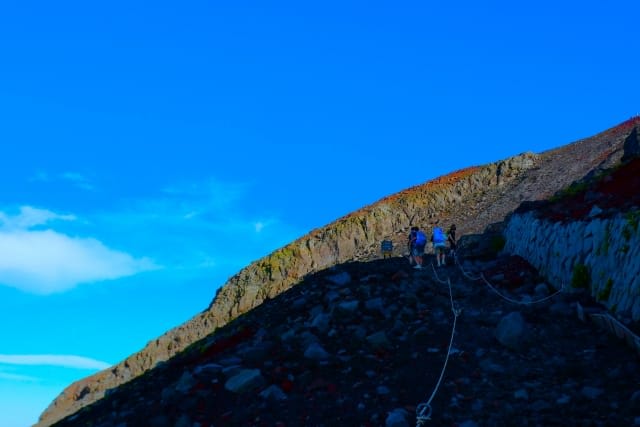
The Yoshida Route on Mt. Fuji's north side and the Subashiri Route (which eventually joins the Yoshida Route) offer excellent sunrise viewing points from almost anywhere. Especially from the higher 8th station and 9th station, the sunrise views rival those from the summit itself.
If you're worried about not making it to the summit in time, don't rush - the sunrise views from the 8th or 9th station are still breathtaking. Since the summit area often gets crowded, consider finding a spot along the way to sit and enjoy the sunrise. Mountain huts are available at the stations, so you might want to stay overnight, wake up before sunrise, and watch it from in front of your hut before continuing to the summit.
Jojudake Area (Southern Summit)
Source:YAMAP
Jojudake is located just past the Yoshida Route summit on the descent path. It's the most popular spot for viewing the sunrise, with many gathering here. The view features nothing but a sea of clouds below, with the majestic sunrise creating a spectacular scene.
Since Jojudake gets crowded, be mindful of others while watching the sunrise. For those seeking a less crowded experience, consider walking another 30 minutes to Asahidake ("Sunrise Peak"). True to its name, it offers beautiful sunrise views and is highly rated by experienced Mt. Fuji climbers.
Summit Temperatures Drop to Below Freezing Even in Summer
While Tokyo and other lowland areas record temperatures above 35°C (95°F) in July and August, the 3,776m summit can experience below-freezing temperatures. During my climb, I even encountered snow in midsummer.
Even at its warmest, the summit temperature rarely exceeds 5°C (41°F). The cold is particularly severe at night, with strong gusts possible, so be sure to bring warm clothing for viewing the Mt. Fuji Sunrise.
Important Notes for Viewing the Sunrise from Mt. Fuji

New Rules Introduced for Mt. Fuji Climbing in 2024
In 2024, four new rules were implemented to ensure safe and comfortable climbing experiences on Mt. Fuji:
Entrance Fee Implementation
A mandatory entrance fee of 2,000 yen has been established for climbing Mt. Fuji.
In 2024, this fee only applies to the Yamanashi Prefecture side, but Shizuoka Prefecture plans to implement it from 2025.
Climber Number Restrictions
Daily climber numbers are limited to 4,000 people. Gates will be closed once this limit is reached, so reservations are essential.
Reservation System Implementation
Climbers can make reservations and pay entrance fees in advance through the reservation system: https://www.fujisan-climb.jp/info/20240510_yoshida_trail_reservation.html
Entry Time Restrictions
Mountain entrance is closed between 16:00 and 3:00.
Only mountain hut users can enter during these hours, but entry outside these times is recommended.
"Bullet Climbing" Banned from 2024
Bullet climbing, which involves climbing through the night to view the Mt. Fuji Sunrise, is now prohibited. This practice increases the risk of altitude sickness and accidents due to sleep deprivation. To prevent bullet climbing, entry restrictions between 16:00 and 3:00 were implemented in 2024. To safely view the sunrise, stay at a mountain hut and plan your climb with plenty of time.
Mountain Hut Reservations Required
Mountain hut reservations are mandatory. These facilities provide accommodation, meals, and free toilet access for guests. Weekends, holidays, and August 10-20 are particularly busy, and reservations may be difficult to secure, especially for huts near the summit. Book as soon as your plans are confirmed.
For information about climbing from Yoshida Trail, visit: https://mtfuji.jpn.org/
Starting at 3 a.m. May Not Get You to the Summit for Sunrise
While entry restrictions lift at 3:00, it takes about 6 hours to reach the summit, making it impossible to catch the Mt. Fuji Sunrise from the top if starting then. For summit sunrise views, overnight at a mountain hut.
The Yoshida Trail, on the north side, offers multiple viewing points for the sunrise during the climb. However, the Fujinomiya Trail on the west side has limited sunrise viewing spots. Therefore, if starting after 3:00, the Yoshida Trail is recommended for those hoping to catch the sunrise during their ascent.
Enjoying Sunrise Views Around Mt. Fuji - A Perfect Combination
While the term "Goraiko" specifically refers to sunrise views from high mountains, the combination of Mt. Fuji and sunrise can be enjoyed year-round from surrounding areas, unlike summit views which are limited to summer season. Here are my personally recommended spots for viewing this magnificent sight...
Lake Motosu

Lake Motosu (Motosuko) is the most famous spot for beautifully viewing Mt. Fuji. The lake has been featured on the old 10,000 yen and 1,000 yen banknotes, making it a familiar sight to many. Recently, it gained international attention after being featured in the anime "Laid-back Camp."
Compared to the popular tourist destination Lake Kawaguchi (Kawaguchi-ko), Lake Motosu offers a quieter area where you can fully immerse yourself in nature. Due to its high altitude and clear air, Mt. Fuji is perfectly reflected on the lake's surface like a mirror. The Mt. Fuji sunrise here is spectacular, especially from late December to early January, when you can witness "Diamond Fuji" - a phenomenon where the sunrise aligns with Mt. Fuji's peak, creating a diamond ring effect.
Access:
- From JR Tokyo Station: Take the Tomei Highway Bus "Fujikyu Highland/Kawaguchi-ko Yamanakako Asahigaoka Line" to Kawaguchiko Station, then take the Lake Motosu Circuit Bus Blue Line to "Motosuko"
- From JR Shinjuku Station: Take JR Chuo Line to Otsuki Station, transfer to Fujikyu Line to Kawaguchiko Station, then take the Lake Motosu Circuit Bus Blue Line to "Motosuko"
Admission: Free
Website: http://motosuko.com/
Dragon God Pond (Ryujin-ike)
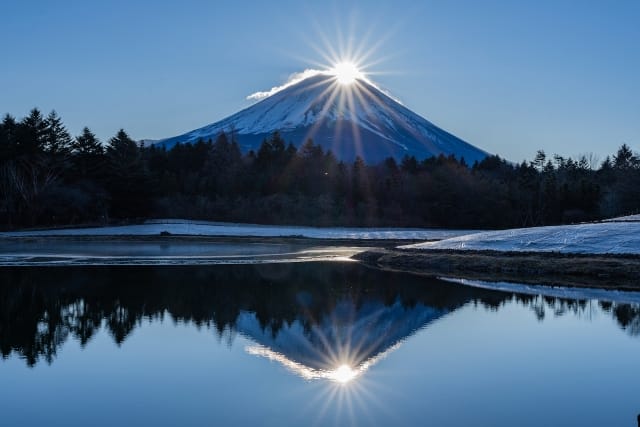
Dragon God Pond is a small lake located slightly beyond Lake Motosu. From mid-April to May, the lakeside is covered with beautiful moss phlox (creeping phlox). The combination of moss phlox and Mt. Fuji creates a breathtaking view, attracting visitors from far and wide. From mid-April to November, a Peter Rabbit-themed café opens within a beautiful English garden setting.
Like Lake Motosu, you can observe Diamond Fuji here during the same season. The Mt. Fuji sunrise viewed from this forest-surrounded lake showcases nature's stunning beauty.
Access:
- From JR Tokyo Station: Take the Tomei Highway Bus to Kawaguchiko Station, then take Fujikyu Shizuoka Bus to "Kenzakai," followed by a 20-minute walk
- From JR Shinjuku Station: Take JR Chuo Line to Otsuki Station, transfer to Fujikyu Line to Kawaguchiko Station, then take Fujikyu Shizuoka Bus to "Kenzakai," followed by a 20-minute walk
Admission: Free
Website: https://www.fujimotosuko-resort.jp/en/ (FUJI MOTOSUKO RESORT)
Mt. Ryugatake
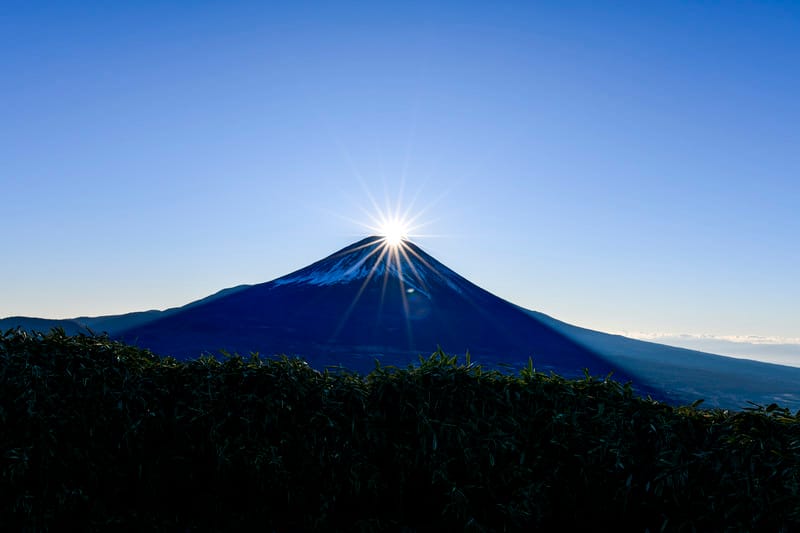
Mt. Ryugatake is a 1,485m mountain along Lake Motosu. While it takes about 1.5 hours to climb from the base to the summit, the view from the top is breathtaking, showcasing the natural beauty surrounding Mt. Fuji.
It's a popular spot among locals for viewing the first Mt. Fuji sunrise of the year on January 1st. During this time, you can also witness Diamond Fuji, offering the perfect morning view. Due to snow during this season, it's recommended to prepare thoroughly with appropriate snow hiking boots.
This spot offers beautiful views of Mt. Fuji year-round, making it ideal for those wanting to try mountain climbing in Japan.
Access:
- From JR Tokyo Station: Take the Tomei Highway Bus to Kawaguchiko Station, then take the Lake Motosu Circuit Bus Blue Line to "Motosuko Tourist Information Center." 20-minute walk to the trailhead, then approximately 1.5 hours to the summit
- From JR Shinjuku Station: Take JR Chuo Line to Otsuki Station, transfer to Fujikyu Line to Kawaguchiko Station, then take the Lake Motosu Circuit Bus Blue Line to "Motosuko Tourist Information Center." 20-minute walk to the trailhead, then approximately 1.5 hours to the summit
Admission: Free
Website: https://yamanashi--hiking100-jp.translate.goog/course/detail/5?_x_tr_sl=ja&_x_tr_tl=en&_x_tr_hl=en
Asagiri Highland
Source:Michi no Eki Asagiri Kogen
The Asagiri Highland (Asagiri Kougen) spreads across the western side of Mt. Fuji. The highland features ranches and camping grounds, making it a popular tourist destination. At Asagiri Highland, visitors have two annual opportunities to witness the "Diamond Mt. Fuji Sunrise" phenomenon.
The best viewing periods are for one week from April 20th and one week from August 20th - tourists visiting during these periods should definitely make time to experience this spectacular sight.
The Asagiri Highland Road Station (Michi no Eki Asagiri Kogen) offers numerous spots with breathtaking views of Mt. Fuji. Their fresh soft-serve ice cream, made right in Asagiri Highland, is exceptional. The facility also includes a food park featuring produce grown at the foot of Mt. Fuji, making it an enjoyable destination for the whole day. After watching the sunrise, we recommend enjoying a meal at the road station.
Access: From JR Tokyo Station, take the Tokaido Shinkansen Kodama (down) to Shin-Fuji Station. From there, take the Fuji Kyuko Shizuoka Bus bound for Mt. Fuji Station and get off at "Michi no Eki Asagiri Kougen"
Admission: Free
Website: https://www.asagiri-kogen.com/
Lake Tanuki

Lake Tanuki (Tanukiko) is situated in Asagiri Highland. Though it's an artificial irrigation lake with a 3.3km circumference, the campground along its shores is surrounded by beautiful nature and is one of the most popular camping sites in the Mt. Fuji area. Like Asagiri Highland, visitors can observe the Diamond Mt. Fuji Sunrise during the same periods. The reflection of this phenomenon on the lake creates a mystical and moving spectacle.
At Kyukamura Fuji, located along Lake Tanuki's shore, visitors can stay in cottages nestled in nature. We recommend staying at a cottage and enjoying the Mt. Fuji Sunrise while taking a morning walk along the lakeshore.
Access: From JR Tokyo Station, take the Tokaido Shinkansen Kodama (down) to Shin-Fuji Station. Take the Fuji Kyuko Shizuoka Bus "Gurutto Fuji Migi Mawari" to Fuji Station. From JR Fuji Station, take the Minobu Line (down) to Fujinomiya Station. From there, take the Fuji Kyuko Shizuoka Bus bound for Kyukamura and get off at "Kyukamura"
Admission: Free
Website: https://www.city.fujinomiya.lg.jp/kankou/llti2b00000018ga.html
Arakurayama Sengen Park

Arakurayama Sengen Park offers a stunning view combining the five-story pagoda of Arakura Fuji Sengen Shrine with Mt. Fuji. This distinctly Japanese vista has gained popularity on social media and is now one of Japan's top tourist destinations.
The Mt. Fuji Sunrise viewed from Arakurayama Sengen Park is spectacular, offering ethereal views of the mountain and pagoda bathed in morning light. During winter, the snow reflects pink and purple hues, creating an impressive beauty unique to this season.
Note that the site can get very crowded at certain times. On weekends between 10:00 AM and 1:00 PM, waiting times can extend to about three hours.
Access:
- From JR Tokyo Station: Take the Tomei Highway Bus "Fuji-Q Highland/Kawaguchiko-Yamanakako Asahigaoka Line" to Kawaguchiko Station. Transfer to the Fuji Kyuko Line and get off at Shimoyoshida Station
- From JR Shinjuku Station: Take the JR Chuo Line to Otsuki Station, transfer to the Fuji Kyuko Line and get off at Shimoyoshida Station
Admission: Free
Website: https://www.city.fujiyoshida.yamanashi.jp/info/151
Arakura Fuji Sengen Shrine: https://www.arakurafujisengen.com/blank-3
